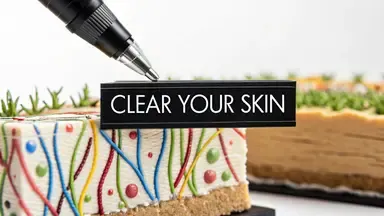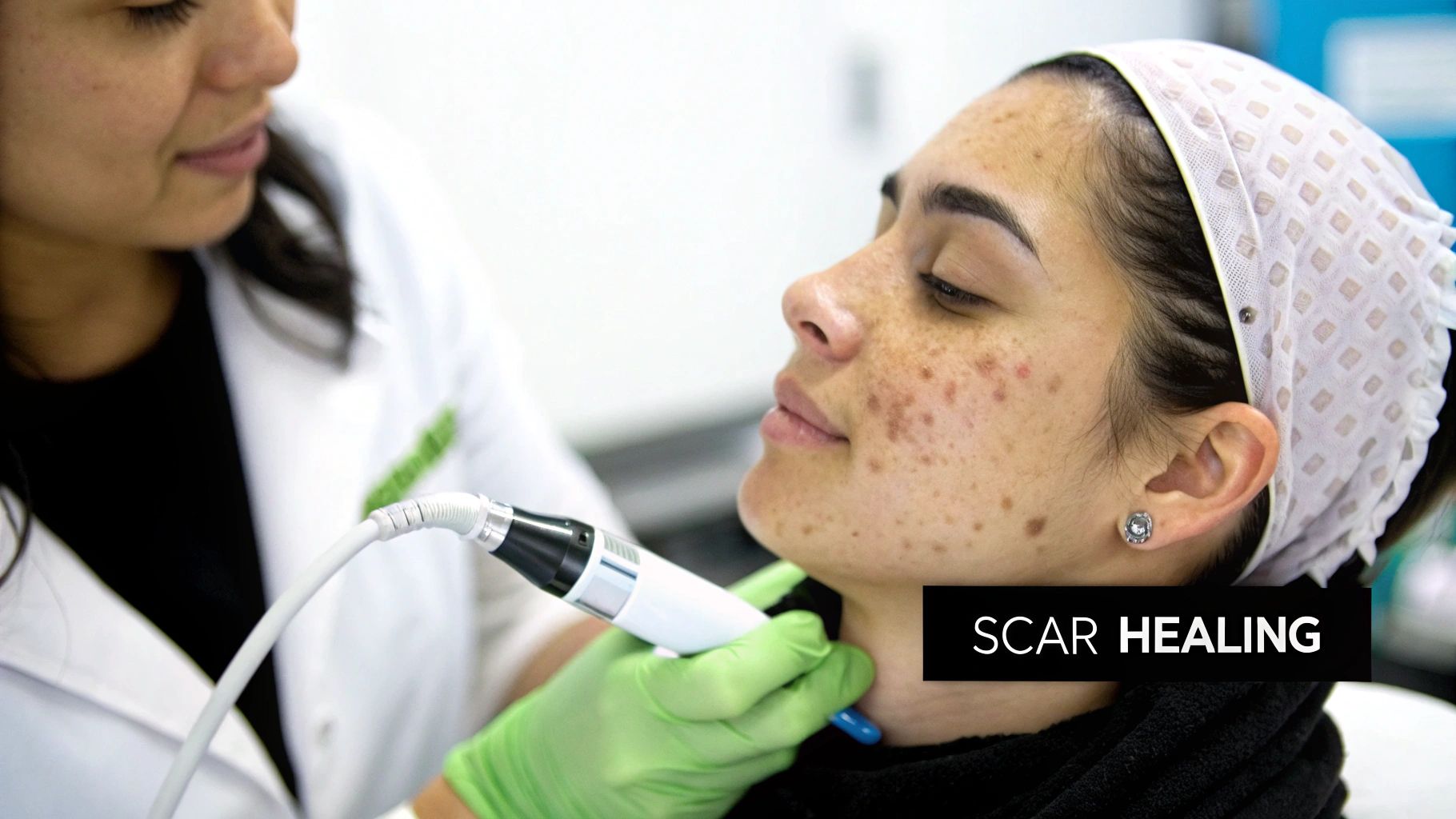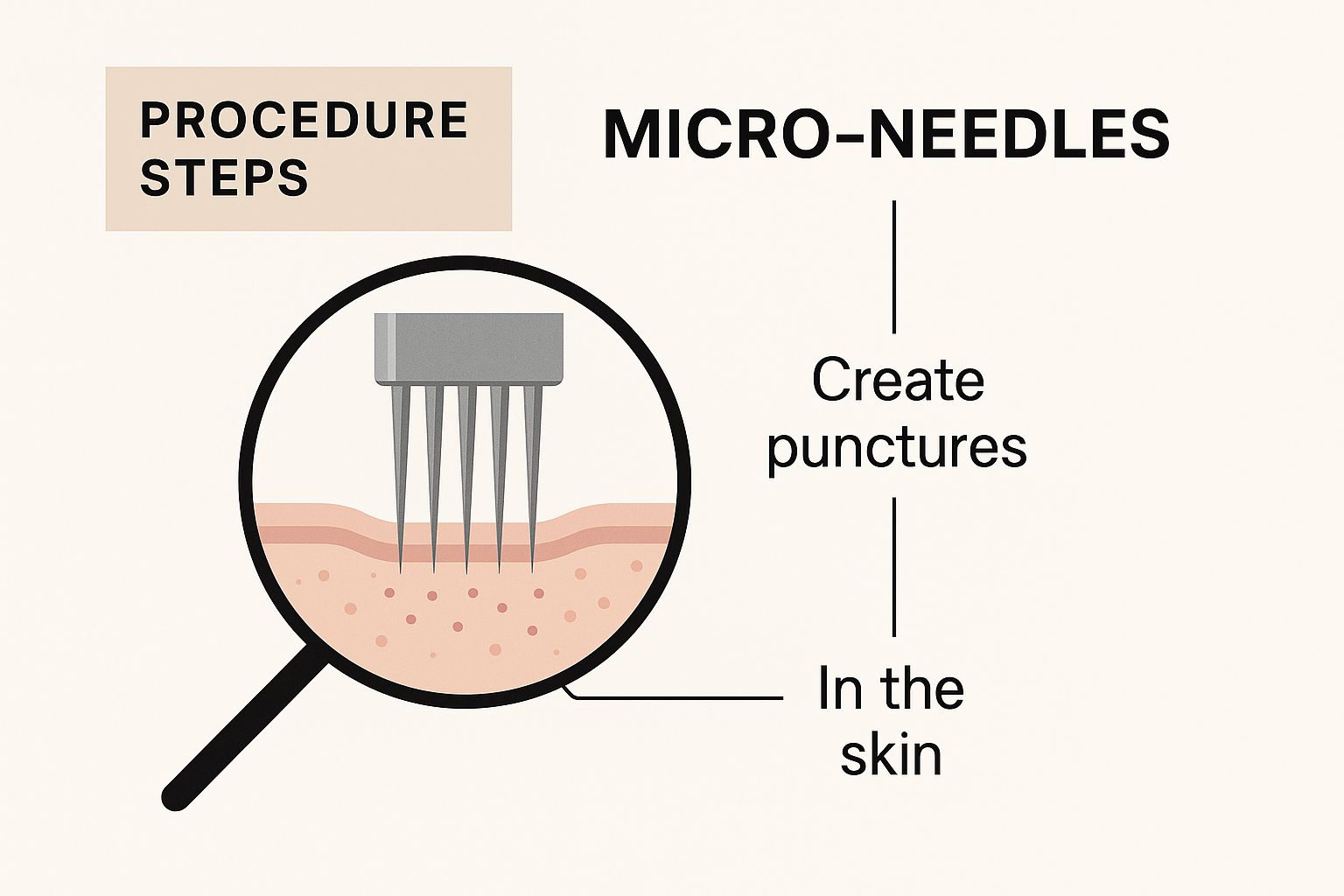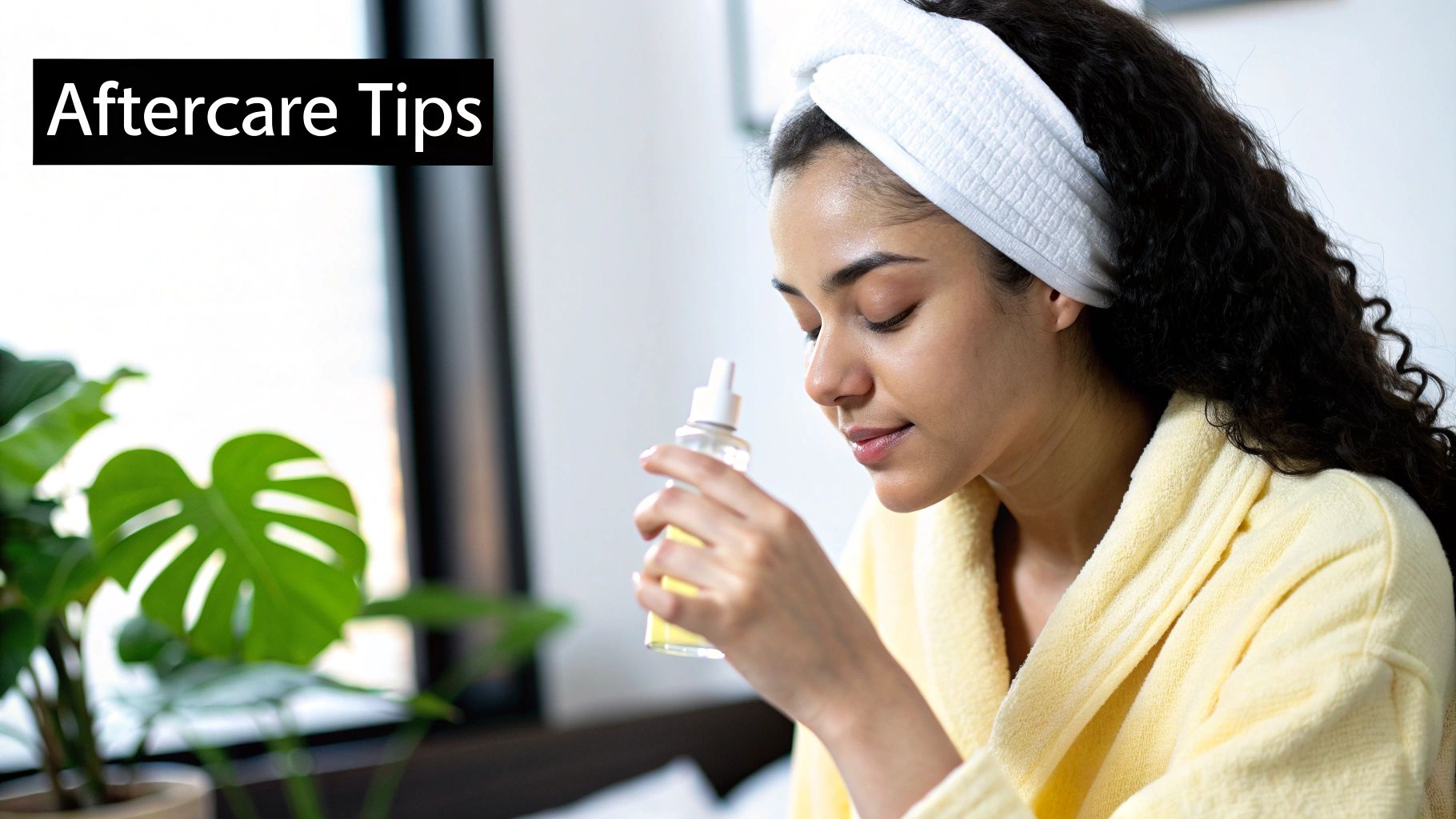
Microneedling for Acne Scars: Clear Your Skin Today
The Science Behind Microneedling’s Acne Scar Magic
Imagine your skin as a beautifully woven tapestry. Acne scars, unfortunately, disrupt that tapestry, leaving behind bumps, dips, and other noticeable imperfections. Microneedling for acne scars works by encouraging your skin's natural repair mechanisms to, essentially, re-weave those damaged areas.
This process, formally known as collagen induction therapy, involves creating tiny, controlled micro-injuries using very fine needles. Think of it like aerating your lawn – you’re creating small holes to encourage new growth and improve the overall health and appearance.
These micro-injuries trigger a cascade of healing responses within your skin. Your skin interprets these tiny punctures as damage and jumps into action, kickstarting the production of new collagen and elastin. These proteins are the essential building blocks of healthy, youthful-looking skin, providing structure, firmness, and that all-important elasticity.
Now, it’s important to understand that this process isn't about creating more scars. Instead, it’s about prompting your body to remodel the existing scar tissue. It’s like demolishing a damaged building and rebuilding it stronger and more beautiful than before. The old, uneven scar tissue is gradually replaced with smoother, healthier skin.
This controlled “wounding” actually boosts collagen and elastin production significantly. Studies have shown that microneedling can result in a whopping 400% increase in collagen and elastin! Discover more insights into the science behind this impressive boost. This increase helps fill in depressed scars like boxcar and rolling scars and can even minimize the appearance of those stubborn ice pick scars.
The image below shows a dermaroller, a common tool used in microneedling:
The close-up view highlights the fine needles that create the micro-injuries, emphasizing the precision of the procedure. The depth of these needles can be adjusted based on the severity of your acne scars, allowing for truly personalized treatments. This targeted approach makes microneedling effective for a variety of scar types and other skin concerns. Interested in diving deeper into the world of microneedling? Check out our guide on microneedling.
From Medical Accident to Modern Miracle Treatment
The story of microneedling, a now common treatment for acne scars, began not in a lab, but with a happy accident. It’s a fascinating example of how sometimes, progress in medicine comes from unexpected places.
The history of dermatology, as seen in the image below, is constantly evolving. Skin conditions have been treated in all sorts of ways throughout time, and new discoveries are always being made.

This Wikipedia screenshot gives you a glimpse into the wide world of dermatology, a field that covers everything from cosmetic procedures to serious skin diseases. Microneedling found its place within this field, evolving from simple tools to the advanced devices we have today.
Early forms of mechanical needling actually date back to 1905. German dermatologist Ernst Kromayer developed a device using rotating wheels and rasps. Imagine a tiny, motorized sander for the skin. He used this to treat issues like acne scars and hyperpigmentation. It was a primitive approach, but it planted the seed for what microneedling would become.
Fast forward to the late 20th century. A Canadian plastic surgeon, Dr. Andre Camirand, noticed something interesting while using tattoo needles on scars. The act of needling itself seemed to improve the scars’ appearance. It was a completely unintentional discovery, but it rekindled interest in the possibilities of mechanical skin needling. Discover more insights.
Dr. Camirand’s observation set off a chain reaction of research and development. Scientists wanted to understand why puncturing the skin with needles could stimulate healing and improve the look of acne scars. This led to refined techniques and the creation of specialized microneedling tools. What started as a chance finding became the precise and effective treatment we know today.
The history of microneedling shows us that innovation can come from anywhere. Knowing this backstory helps us appreciate how this acne scar treatment came to be, building on decades of observation and improvement. It also highlights how important ongoing research is, and the potential for even more advancements in the future.
Matching Treatment To Your Unique Scar Landscape
Think of acne scars as a personal skin history, each telling a different story. Some are deep, narrow "ice pick" scars, while others are softer, rolling contours. Microneedling offers a way to address these individual scar stories, adapting to your unique skin terrain.
Imagine microneedling as a tiny, controlled remodeling project for your skin. The infographic below illustrates how it works: tiny needles create miniature punctures, prompting your skin's natural healing response.

These micro-injuries stimulate the production of collagen, a protein that gives skin its structure and elasticity. This targeted collagen boost is the key to smoothing out those scar stories. The treatment’s depth can be adjusted depending on the scar type.
Different Scars, Different Approaches
For instance, those deep ice pick scars often need a more intensive approach – longer needles and multiple sessions. Think of it like digging deeper foundations for a taller building. Shallower "boxcar" scars, on the other hand, might respond well to less intensive treatment. This is because we need to reach the right skin depth for effective collagen remodeling.

This screenshot from Wikipedia shows the different forms acne can take, reminding us of how varied its impact can be. Understanding these variations helps explain why some scars require a more tailored treatment strategy.
Your Skin's Unique Response
Beyond scar type, your skin tone and natural healing ability also play a role. Some people see significant improvement after a few sessions, while others need more time. Just like any healing process, patience is key. Microneedling isn't a one-size-fits-all solution; it's about understanding your unique skin and tailoring the treatment accordingly.
To help illustrate the connection between scar type and treatment, let's look at this table:
Acne Scar Types and Microneedling Effectiveness
Scar Type Description Microneedling Effectiveness Sessions Needed Expected Improvement Ice Pick Scars Deep, narrow scars Moderate to High 4-6+ 50-70% Rolling Scars Wavy, undulating scars High 3-5 60-80% Boxcar Scars Broad, shallow scars with defined edges Moderate to High 3-4 50-75% Hypertrophic Scars Raised, thickened scars Low to Moderate Varies 30-50%
This table summarizes how microneedling generally performs with different scar types. It's important to remember these are estimates, and individual results can vary.
Knowing your specific scar pattern helps set realistic expectations and makes your treatment journey more informed and empowering. It allows you and your practitioner to collaborate on a plan that addresses your unique skin concerns.
Your First Appointment: What Really Happens Behind Closed Doors
Walking into your first microneedling appointment for acne scars doesn't have to be a nerve-wracking experience. Let's break down what you can expect, from the initial consultation to the aftercare.
The Consultation: Mapping Out Your Skin Journey
Your first appointment begins with a detailed skin assessment. Think of it as a roadmap session for your skin. The practitioner will examine your acne scars, taking note of their type, depth, and how they're distributed. This isn't about judgment; it's about understanding your unique skin and tailoring a treatment plan just for you. They'll likely ask about your current skincare routine, as some products might need a temporary pause before and after the treatment to maximize effectiveness. You'll also have a chance to discuss your goals, so the practitioner can set realistic expectations.
The Procedure: Tiny Needles, Powerful Results
After the consultation, the actual microneedling procedure begins. Your skin will be cleansed and a numbing cream applied to ensure your comfort. The practitioner then uses a microneedling device – either a roller or a pen – to create controlled micro-injuries. Imagine it like aerating your lawn; those tiny punctures encourage your skin to regenerate itself. Many describe the sensation as a light tingling or prickling. The practitioner carefully controls the needle depth based on your individual scar type and skin condition. This precise approach stimulates the production of collagen and elastin, the building blocks of healthy, smooth skin.
Immediate Aftermath: A Little Redness, A Lot of Renewal
Right after the treatment, your skin might look a bit red, similar to a mild sunburn. This is completely normal and shows that the healing process is underway. You might also notice some slight swelling or sensitivity. To soothe and hydrate your skin, the practitioner will apply a calming serum or mask. You'll also receive detailed aftercare instructions specific to your needs, setting you up for success at home.
Preparing for Your Appointment: Setting Yourself Up for Success
A few days before your appointment, avoid harsh exfoliants or retinoids. Arrive with a clean face, ready to discuss your medical history and any allergies. Don't be afraid to ask questions! A good practitioner welcomes your curiosity and will gladly explain every step. Dermatologists often suggest four to six microneedling sessions for the best scar reduction results. Each session typically lasts 30 minutes to an hour and can cost anywhere from $200 to $800, depending on the clinic and location. Discover more insights. You can also schedule a consultation with a qualified practitioner to discuss your individual needs and concerns. Ready to book? You might be interested in booking a microneedling session.
This screenshot from Wikipedia's Dermatology page highlights the wide range of skin conditions and treatments that fall under this medical specialty. Microneedling is considered a cosmetic dermatology procedure, further validating its role in improving skin appearance. This underscores the importance of seeking treatment from qualified professionals within the field of dermatology.
The Real Numbers: Investment Costs and Honest Results
Let's talk about money. Microneedling for acne scars is an investment in your skin, and it’s important to have a realistic understanding of the costs and potential results before you begin.
Decoding the Price Tag: Why Costs Vary
Think of microneedling prices like airline tickets – they’re constantly fluctuating. Several factors influence the cost, including your location, the clinic's reputation, the practitioner's experience, and the specific technology used. Big city clinics often charge more than those in smaller towns, much like rent in a bustling metropolis versus a quieter suburb. Similarly, a specialized clinic with cutting-edge equipment might have higher prices than a standard medspa.
The number of sessions needed also impacts the overall cost. More severe scarring or specific skin concerns might require multiple treatments. It’s like repainting a house: a small touch-up is cheaper than a full exterior overhaul.

Beyond the Hype: Understanding Real Patient Experiences
While those before-and-after photos can be impressive, it's crucial to remember that everyone’s skin is different. Patient satisfaction with microneedling is generally high, with over 80% of patients recommending the procedure for scar management. They often report noticeable improvements in skin texture and scar appearance. Discover more insights. However, just like with any other treatment, individual results can vary.
Factors Influencing Your Results
Your age, skin type, the severity of your scars, and your overall health all play a role in how your skin responds to microneedling. Younger skin, which produces collagen more readily, might bounce back faster and show more dramatic results. Deeper scars might require more sessions. Think of it like nurturing a plant: some sprout quickly, while others need more time and care to flourish.
Making Informed Decisions: Balancing Cost and Expectations
Before scheduling your first appointment, have a frank conversation with a qualified practitioner. Discuss your goals, your budget, and your expectations. A good practitioner will help you understand realistic outcomes and provide a clear cost breakdown. They can also tailor a treatment plan that addresses your specific needs.
To give you a general idea of the costs, let’s look at this table:
Microneedling Treatment Costs and Value Breakdown
This table outlines the typical price ranges for different types of microneedling, along with the estimated number of sessions needed and the total investment.
Treatment Type Price Range Sessions Needed Total Investment Value Factors Basic Microneedling $200-$400 4-6 $800-$2400 Improves texture, reduces mild scarring Microneedling with Radiofrequency $400-$800 3-4 $1200-$3200 Enhanced collagen stimulation, deeper scar treatment Microneedling with PRP $500-$1000 3-5 $1500-$5000 Accelerated healing, improved skin rejuvenation
Remember, these are just estimates. Actual prices can vary, so consult with a qualified practitioner for a personalized quote. By understanding the factors that influence both cost and results, you can make an informed choice about whether microneedling fits your needs and budget.
Post-Treatment Success: The Aftercare That Makes All the Difference
Your microneedling session for acne scars is complete, but the journey to smoother skin has just begun. The days following your treatment are incredibly important. Think of your skin like a garden after you've planted seeds – it needs the right care to truly flourish.
Immediate Post-Treatment: Soothing and Protecting
Immediately after microneedling, your skin might look red and feel a little swollen, similar to a mild sunburn. This is a perfectly normal reaction to the micro-injuries created during the procedure. Your practitioner will likely apply a calming serum or mask to soothe the treated area. For the first few days, your focus should be on keeping your skin clean and well-hydrated. Gentle cleansers and hydrating serums are your best allies during this initial phase.
After a microneedling treatment, your skin needs extra hydration and should be cared for using gentle cleansers and hydrating serums.
The First Week: Gentle Care Is Key
For the first week post-treatment, avoid harsh skincare products like exfoliants, retinoids, and anything containing active ingredients such as AHAs or BHAs. These can irritate your sensitive skin and interfere with the healing process. Imagine adding strong fertilizer to a newly seeded lawn—too much too soon can do more harm than good. Instead, stick to gentle, fragrance-free products designed for sensitive skin. Sun protection is also crucial. Your skin is much more vulnerable to sun damage after microneedling, so be sure to apply a broad-spectrum sunscreen with an SPF of 30 or higher every day, even if it’s cloudy.
Sun protection is crucial after microneedling, and it’s important to use a broad-spectrum sunscreen with at least SPF 30.
Long-Term Care: Maintaining Your Results
As your skin heals, you can gradually reintroduce your regular skincare routine. However, continue to prioritize hydration and sun protection. These are essential for maintaining your microneedling results and keeping your skin healthy and vibrant long-term. For personalized aftercare advice, a custom facial can address your specific needs.
Staying hydrated and using sun protection regularly is essential to maintain the positive effects of your microneedling treatment.
Recognizing Healthy Healing vs. Red Flags
Most people experience mild redness, swelling, and some dryness for a few days after microneedling. These are positive signs that the healing process is underway. However, if you experience excessive redness, swelling, pain, or any signs of infection, it's important to contact your practitioner right away. Knowing the difference between typical healing and potential complications is key.
Real Patient Experiences: Learning From Others' Journeys
Many patients say their skin feels a little tight or sensitive in the days following microneedling. Some notice minor flaking or peeling as their skin regenerates. These are typically temporary and resolve naturally. Hearing about other people's experiences can offer helpful insights into the healing process and manage expectations. One patient shared, "My skin was a bit pink for a few days, but by the end of the week, it felt smoother and looked more even." Another said, "The dryness was more noticeable than I anticipated, but using a hydrating serum really helped."
By understanding the importance of post-treatment care and following these guidelines, you'll be well on your way to maximizing your results and enjoying the full benefits of microneedling for acne scars. Remember, achieving your skin goals is a journey, and proper aftercare is your roadmap to success.
Your Path Forward: Making the Right Decision For Your Skin
Microneedling for acne scars holds real promise, but it's not a one-size-fits-all solution. Figuring out if this treatment is a good fit for your skin type, scar type, and lifestyle is key to getting the results you want. This section will guide you through that process, giving you the knowledge you need to choose the best path forward.
Are You a Candidate? Factors to Consider
Several factors, like pieces of a puzzle, come together to determine if microneedling is right for you. Your skin type is a major one. While generally safe for all skin tones, if you have active acne or conditions like eczema or psoriasis, you might need to consider other options or adjust the treatment plan. The types of acne scars you have also matters. Deep, ice pick scars might require more sessions than rolling or boxcar scars. And finally, your lifestyle can affect healing and recovery. For example, if your job involves a lot of sun exposure, you'll need to take extra precautions after treatment.
Setting Realistic Expectations: A Journey, Not a Quick Fix
It’s important to remember that microneedling is a journey, not an overnight miracle. Results usually appear gradually over a few sessions. Think of it like nurturing a plant: consistent care and patience are key for it to flourish. Your skin needs that same time and care to rebuild collagen and elastin after each treatment. Talking honestly with dermatologists and looking at before-and-after photos of other patients can give you a realistic idea of what improvements to expect based on your situation. This helps you make informed decisions and avoid disappointment.
Choosing the Right Practitioner: Your Partner in Skin Health
Finding a qualified practitioner is crucial for safe and effective microneedling. It's like choosing a skilled architect for a home renovation. You want someone experienced, detail-oriented, and committed to quality. Look for licensed professionals with specific training in microneedling and a solid understanding of skin anatomy and conditions. A thorough consultation is a must. Ask about their experience, treatment protocols, and aftercare instructions. Don’t hesitate to ask about potential risks and side effects. A trustworthy practitioner welcomes your questions and provides clear answers.
Red Flags to Watch For: Protecting Your Investment
While most practitioners are reputable, it’s smart to be aware of potential red flags to protect your investment and your skin. Be wary of clinics that promise unrealistic results or push aggressive treatment plans. Unusually low prices can be a sign of subpar equipment or inexperienced staff. Do your research on the clinic’s reputation and check patient reviews. A transparent and informative consultation is a positive sign, while evasiveness or pressure tactics should raise a red flag. Trust your gut and prioritize your safety and well-being.
Ready to start your journey to clearer skin? Schedule a consultation at Olive Skin Therapy today. Our team of experienced aestheticians will assess your individual needs and create a customized treatment plan designed for your unique skin concerns.
Learn more about Olive Skin Therapy and book your appointment to discover the potential of personalized skincare.
